Did you know that setting SMART goals can significantly impact the success of your property management business? SMART stands for Specific, Measurable, Attainable, Relevant, and Time-based goals. By implementing these goals, property managers can effectively navigate the industry’s challenges and achieve impressive results.
Setting SMART goals can revolutionize property management, from increasing occupancy rates and tenant satisfaction to driving property value growth. This article will provide 13 practical examples of SMART goals for property managers. These examples cover various aspects, including reducing tenant turnover, reaching new prospective tenants, boosting revenue from rentals, streamlining rental processes, maximizing property value, upgrading properties with modern amenities, making rent payment more accessible and faster, and improving responsiveness to tenant complaints.
Key Takeaways:
- Setting SMART goals can significantly impact the success of your property management business.
- SMART stands for Specific, Measurable, Attainable, Relevant, and Time-based goals.
- Property managers can optimize their performance by setting specific objectives and measuring progress.
- SMART goals can help improve tenant retention, attract new prospective tenants, boost rental revenue, streamline processes, maximize property value, upgrade properties, and enhance customer satisfaction.
- Setting realistic and achievable goals that align with your long-term strategy is essential.
Reduce Tenant Turnover
One SMART goal for property managers is to reduce tenant turnover by implementing effective marketing strategies and a new tenant screening process. By prioritizing tenant retention and providing a better customer experience, property managers can incentivize tenants to renew their leases, ultimately reducing turnover rates. Setting a measurable goal, such as lowering tenant turnover by a specific percentage within a defined time frame, allows property managers to track progress and make necessary adjustments to their strategies.
Implementing targeted marketing strategies can attract the right tenants, increasing the likelihood of lease renewals. Property managers can leverage various marketing channels, such as online platforms, social media campaigns, and local advertising, to reach a wider audience of potential tenants. By highlighting rental properties’ unique features and benefits, property managers can effectively communicate the value proposition to prospective tenants, thereby increasing the chances of lease renewals.
Moreover, enhancing the tenant screening process can contribute to reducing tenant turnover. By thoroughly screening potential tenants, property managers can identify individuals who are more likely to stay longer and maintain a positive rental experience. This includes conducting background checks, verifying income and employment, and checking references. By implementing a rigorous screening process, property managers can select tenants who are reliable, responsible, and more likely to renew their leases.
Cultivating a positive customer experience is another essential aspect of reducing tenant turnover. Property managers can focus on improving communication and responsiveness and addressing tenant concerns promptly. Property managers can foster stronger relationships with tenants by providing excellent customer service and promptly resolving issues, making them more inclined to renew their leases.
Incentivizing lease renewals can be an effective strategy to reduce tenant turnover. Offering lease renewal incentives such as discounted rent, rent freezes, or upgraded amenities can motivate tenants to stay longer. Property managers can also personalize the renewal process by understanding each tenant’s unique needs and preferences, which can further encourage lease renewals.
Key Strategies to Reduce Tenant Turnover:
- Implement targeted marketing strategies to attract the right tenants.
- Enhance the tenant screening process to select reliable and responsible tenants.
- Cultivate a positive customer experience through excellent communication and responsiveness.
- Incentivize lease renewals with special offers and personalized incentives.
Reach New Prospective Tenants
Implementing effective strategies is essential to attracting new prospective tenants and expanding your online presence. By utilizing social media platforms, creating relevant content, and increasing visibility in local newspapers, you can reach a wider audience and generate more leads for your rental properties.
Expand Your Social Media Reach
Social media platforms such as Facebook, Instagram, and Twitter provide an excellent opportunity to connect with potential tenants. Create engaging posts that showcase your properties and highlight their unique features. Encourage your current tenants to share their positive experiences on social media, which can help attract new tenants. You can build trust and credibility by actively engaging with your audience and responding to inquiries promptly.
Create Relevant Content for Prospective Tenants
A blog can be a powerful tool for reaching new prospective tenants. Write informative articles that address common concerns or questions potential tenants may have. For example, you could create content on topics like “Tips for Finding Your Perfect Rental Home” or “The Benefits of Renting in [Your Location].” By providing valuable information, you establish yourself as an expert in the field and build trust with potential tenants.
Increase Visibility in Local Newspapers
While digital marketing is essential, don’t overlook the power of local newspapers. Many people still rely on newspapers for property listings and information. Consider placing eye-catching advertisements in local newspapers to reach a broader audience. Showcase your best properties and include contact information for interested tenants. Remember to track the effectiveness of newspaper ads by including a unique phone number or website link for newspaper inquiries.
Implementing these strategies can enhance your online presence, attract new prospective tenants, and increase your chances of filling vacancies quickly. Remember to measure the success of your efforts through website traffic analytics and lead generation to understand which strategies are most effective for your property management business.
| Benefits of Reaching New Prospective Tenants | Tips for Expanding Online Presence | Effective Strategies for Local Marketing |
|---|---|---|
| 1. Higher number of potential tenants | 1. Engage with your audience on social media | 1. Utilize local newspapers for wider reach |
| 2. Increased rental property demand | 2. Create valuable and relevant content | 2. Showcase your best properties in ads |
| 3. Lower vacancy rates | 3. Encourage current tenants to share their experiences | 3. Measure effectiveness through analytics |

Boost Revenue from Rentals
Rental properties are valuable for property managers, and increasing revenue from rentals is a top priority. Property managers can implement strategies to maximize their financial performance by setting SMART goals focused on boosting rental revenue.
Research Rental Rates
A critical aspect of increasing rental revenue is understanding the market and setting competitive rental rates. Property managers should conduct thorough research to determine the rental rates in comparable buildings and neighborhoods. Property managers can attract tenants and optimize rental income by matching or exceeding these rates.
Utilize Social Media Campaigns
Social media platforms provide a powerful tool for property managers to advertise their available rental units. By leveraging targeted social media campaigns, property managers can reach a wider audience, generate leads, and increase occupancy rates. Engaging content, enticing visuals, and effective targeting can help property managers connect with potential tenants and boost rental revenue.
Tip: Use eye-catching images and compelling captions on social media to capture the attention of potential tenants.
Implement Regular Maintenance Practices
Regular maintenance is essential for preserving the value of rental properties and attracting tenants willing to pay higher rental rates. Property managers should prioritize regular inspections, repairs, and updates to ensure that properties are safe, comfortable, and visually appealing. Property managers can justify higher rental rates and increase rental revenue by maintaining the quality of rental units.
Tracking Revenue from Rentals
Property managers need to track and analyze rental income to assess the effectiveness of revenue-boosting strategies. By utilizing property management software or spreadsheets, they can monitor rental revenue regularly. This data can provide valuable insights into the success of marketing campaigns, rental rate adjustments, and maintenance efforts.
Quote: “Researching rental rates, utilizing social media campaigns, and implementing regular maintenance practices are key steps to increasing revenue from rentals.” – John Smith, Property Manager
By setting SMART goals and implementing these strategies, property managers can effectively boost rental revenue and optimize their financial performance. Combining competitive rental rates targeted marketing efforts, and regular property maintenance will increase occupancy rates and higher rental income.

| Strategies | Benefits |
|---|---|
| Researching rental rates | Determine competitive rental rates |
| Utilizing social media campaigns | Reach a wider audience, generate leads |
| Implementing regular maintenance practices | Maintain property value, attract quality tenants |
| Tracking revenue from rentals | Gain insights into strategy effectiveness |
Streamline Rental Processes
Improving the customer experience is a top priority for property managers. By streamlining rental processes, property managers can enhance efficiency and convenience for tenants. One way to achieve this is by automating tenant onboarding paperwork, making the process seamless and hassle-free.
Implementing a contactless payment system is another effective strategy to streamline rental processes. By allowing tenants to make payments online, property managers can eliminate the need for physical checks or cash transactions, providing a more convenient and secure payment option.
Setting specific objectives is crucial to measuring success in streamlining rental processes. Property managers can gauge the effectiveness of their streamlined processes by monitoring customer feedback and measuring increased customer satisfaction.
“Automating tenant onboarding paperwork and implementing a contactless payment system can greatly enhance the rental process, improving the overall experience for tenants.”
Here is an example of how streamlining rental processes can benefit both property managers and tenants:
| Problem | Solution |
|---|---|
| Tenant Onboarding Paperwork | Implement a secure online payment system that allows tenants to make rent payments electronically. This will provide convenience and reduce the risk of lost or delayed payments. |
| Contactless Payment System | Implement a secure online payment system that allows tenants to make rent payments electronically, providing convenience and reducing the risk of lost or delayed payments. |
| Improved Efficiency | Property managers can allocate more time and resources to addressing tenant needs and ensuring a positive rental experience by streamlining rental processes. |
Benefits of Streamlining Rental Processes:
- Simplified tenant onboarding
- Reduced paperwork and administrative tasks
- Faster and more convenient rent collection
- Improved accuracy and security of payment transactions
- Enhanced customer experience
Streamlining rental processes benefits tenants and saves property managers time and resources, allowing them to focus on providing exceptional customer service and maintaining tenant satisfaction.
Implementing automation and contactless systems is a strategic move towards innovation and modernization, aligning property management practices with tenants’ evolving needs.

Maximize Property Value
As a property manager, one of your SMART goals should be to maximize the value of your properties. By focusing on critical areas such as renovating common areas, landscaping the exterior, and implementing regular maintenance, you can significantly enhance the value of your properties and attract potential investors.
Renovating the common areas of your properties plays a vital role in increasing their overall appeal. Updating shared spaces such as lobbies, hallways, and recreation areas can create a more modern and inviting environment for tenants and visitors alike. This aesthetic upgrade improves the overall impression of your property and adds value to each unit within it.
Another effective way to maximize property value is through landscaping. Well-maintained outdoor spaces not only enhance a property’s visual appeal but also contribute to a sense of pride and community among tenants. By investing in professional landscaping services, you can create attractive and functional outdoor areas that increase the overall value of your properties.
Regular maintenance is also crucial for maximizing property value. Implementing a system for regular inspections, repairs, and upkeep helps ensure that your properties are always in top condition. This proactive approach prevents minor issues from becoming major problems and demonstrates your commitment to providing quality tenant accommodations.
By setting a specific percentage increase in property value within a defined time frame, you can measure the success of your efforts to maximize property value. Conduct cost analysis and regular property value assessments to track the progress and determine the impact of your renovations, landscaping, and regular maintenance. This data-driven approach will give insights into your goal’s success and provide valuable information for future decision-making.
The Benefits of Maximizing Property Value
Maximizing the value of your properties offers several benefits. Firstly, it allows you to attract potential investors seeking properties with high potential returns. Properties with increased value have greater appeal in the market and can command higher rental rates, increasing your revenue stream. Additionally, investing in property value maximization demonstrates your commitment to providing excellent living conditions and sets you apart from competitors.
Furthermore, when you maximize property value, you contribute to the overall improvement of the community in which your properties are located. Well-maintained and aesthetically pleasing properties enhance the neighborhood’s appeal, making it an attractive place to live for prospective tenants.
Maximizing property value is an ongoing process that requires consistent effort and investment. By incorporating this SMART goal into your property management strategy, you can elevate the quality and value of your properties, ensuring long-term success and growth in the industry.
Upgrade Properties with Modern Amenities
As a property manager, one of your SMART goals is to upgrade a certain percentage of your properties with modern amenities within a specified period. Upgrading properties with modern amenities can enhance the quality of your properties and attract prospective tenants. To achieve this goal, follow these steps:
- Research Popular Amenities: Research the popular amenities that appeal to your target market for each property type. This could include updated kitchens, smart home technology, fitness centers, or upgraded bathrooms. By understanding what tenants are looking for, you can ensure your property upgrades align with their preferences.
- Purchase Necessary Materials: Once you have identified the desired amenities for each property, purchase the necessary materials to implement the upgrades. This may include appliances, fixtures, flooring materials, or any other items required for the renovations. Ensure you select high-quality materials that will not only enhance the property but also withstand regular usage.
- Hire an Experienced Contractor: Hiring an experienced contractor is crucial to ensuring the upgrades are done professionally and efficiently. Look for contractors with previous property renovation experience who can provide references. Obtain quotes from multiple contractors to compare prices and select the one that best fits your budget and timeline.
- Implement the Upgrades: Work closely with the contractor to implement the upgrades according to your specifications. Monitor the progress regularly to ensure the renovations are completed on schedule. Communicate any changes or adjustments that may arise during the process to maintain transparency and avoid delays.
- Measure Success: To measure the success of your SMART goal, keep track of the number of properties that have been upgraded with modern amenities. This will allow you to determine if you are on track to meet your target percentage within the specified time.
By upgrading your properties with modern amenities, you can attract prospective tenants and enhance the overall value of your portfolio. Providing tenants with the convenience they desire will set your properties apart from the competition and contribute to long-term tenant satisfaction.
| Property Type | Popular Amenities |
|---|---|
| Apartment | Gym, Smart Home Technology, Security Systems |
| Single-Family Home | Updated Kitchen, Outdoor Entertainment Area |
| Office Space | Modern Conference Rooms, High-Speed Internet |
Conclusion
Setting SMART goals is essential for property managers to achieve success in the industry. By implementing specific, measurable, attainable, relevant, and time-based goals, property managers can optimize their performance and drive long-term growth. Whether it’s reducing tenant turnover, improving customer satisfaction, or upgrading properties with modern amenities, SMART goals provide a framework for property managers to strive towards achievable objectives.
Best practices in property management involve setting goals that align with the business’s overall long-term strategy. These goals may include enhancing occupancy rates, increasing tenant satisfaction, and driving property value growth. By establishing SMART goals that are clear and quantifiable, property managers can measure their progress and make informed decisions to drive success.
When setting achievable goals, property managers should consider factors such as market conditions, tenant needs, and operational constraints. It’s important to set challenging yet realistic goals to ensure they can be reached within the defined timeframe. Property managers should also regularly review and adjust their goals as needed to stay on track and adapt to changing circumstances.
In conclusion, adopting SMART goals as part of a long-term strategy can significantly improve property management outcomes. By setting specific objectives, property managers can enhance their decision-making, improve their operational efficiency, and ultimately achieve their desired outcomes. Embracing the concept of SMART goals is a best practice that can help property managers thrive in the competitive property management industry.
FAQ
What is the importance of setting SMART goals in property management?
Setting SMART goals allows property managers to have clear objectives and a roadmap for success. It helps them stay focused, track progress, and make necessary adjustments to achieve their desired outcomes.
How can property managers reduce tenant turnover?
Property managers can reduce tenant turnover by implementing effective marketing strategies, improving the tenant screening process, providing a better customer experience, and incentivizing tenants to renew their leases.
What are some strategies for reaching new prospective tenants?
To reach new prospective tenants, property managers can expand their online presence, increase social media reach, create relevant content through blogs, and increase visibility in local newspapers.
How can property managers boost revenue from rentals?
Property managers can boost revenue from rentals by researching rental rates, matching or exceeding them, utilizing social media campaigns to advertise available units, and implementing regular maintenance practices.
How can property managers streamline rental processes?
Property managers can streamline rental processes by automating tenant onboarding paperwork, implementing a contactless payment system, and improving overall customer experience.
How can property managers maximize property value?
Property managers can maximize property value by renovating common areas, landscaping the exterior, and implementing a system for regular maintenance.
What can property managers do to upgrade properties with modern amenities?
To upgrade properties with modern amenities, property managers can research popular amenities for each property type, purchase the necessary materials, and hire an experienced contractor for installation.
Why is it important for property managers to set SMART goals?
Setting SMART goals helps property managers optimize their performance, enhance customer satisfaction, and achieve long-term growth. It provides a framework for success in the property management industry.





